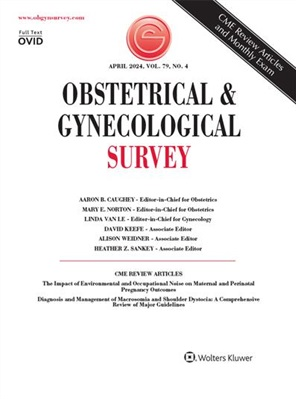Enhanced Recovery After Surgery (ERAS®) Society Guidelines for Gynecologic Oncology: Addressing Implementation Challenges - 2023 Update
IF 4.3
4区 医学
Q1 OBSTETRICS & GYNECOLOGY
引用次数: 0
Abstract
ABSTRACT Implementation of the Enhanced Recovery after Surgery (ERAS) Society Guidelines in 2016 has resulted in an approximate decrease in hospital length of stay (LOS), reduction in complications and readmission, and cost saving. Recent publications however have demonstrated that barriers and gaps in understanding may result in many ERAS recommendations being poorly adhered to in gynecologic oncology patients. The aims of this second update to the ERAS Society Guidelines for gynecologic oncology is to summarize and update the evidence investigating specific implementation challenges to increase ERAS uptake and improve clinical outcomes for patients. A literature search was conducted for topics specified to 9 ERAS implementation challenges identified: perioperative oral intake safety, preoperative medication importance, penicillin allergies, intraoperative analgesia, how to manage urinary drainage, venous thromboembolism prophylaxis, postoperative opioid prescription practices, same-day discharge programs, and how can I overcome barriers to ERAS implementation. The quality of evidence and recommendations was evaluated, and recommendations graded as strong or weak based on quality, balance between desirable and undesirable effects on holistic clinical outcomes, and on values and preferences of practitioners. Regarding perioperative oral intake safety, patients should be encouraged to consume clear liquids in 2 hours before surgery and preoperative carbohydrate loading improves satisfaction and comfort. Optimal preoperative medications include nonsteroidal anti-inflammatory drugs, acetaminophen, and gabapentinoids. Patients with penicillin allergies should receive standard surgical antibiotic prophylaxis. For intraoperative analgesia, wound infiltration with local anesthetic and TAP block are preferred over thoracic epidural analgesia. Indwelling bladder catheters should be removed as early as possible in the postoperative period such as on the day of surgery for minimally invasive procedures and no later than postoperative day 1 for laparotomy. Patients at increased risk of venous thromboembolism should receive dual prophylaxis with compression and medications, and extended chemoprophylaxis should be prescribed to those with high-risk criteria or after laparotomy. Multimodal opioid-reduction is critical for all patients, and decreased postdischarge opioid proscribing is improved with a team approach and does not affect pain control or patient satisfaction. Patient controlled analgesia is a last resort for those requiring repeated treatment with intravenous opioids. Multidisciplinary same-day discharge programs should be considered in minimally invasive surgeries, and implementation requires a multidisciplinary team approach with patient education, case selection, and ERAS principles. Overcoming barriers to ERAS principles is more successful with changes at the management level and education. Communication of the economic benefits of ERAS to administrators may be a strong incentive to garner support. Although the evidence level varied between moderate and strong for each of these recommendations, the recommendation grade for each was strong. This updated ERAS guideline focuses on addressing implementation challenges and controversial aspects of ERAS defined by a stakeholder clinician group and offers suggestions based on objective data for overcoming these barriers.增强术后恢复(ERAS®)妇科肿瘤学会指南:解决实施挑战- 2023年更新
2016年实施的促进术后恢复(ERAS)协会指南导致住院时间(LOS)的大致减少,并发症和再入院的减少,并节省了成本。然而,最近的出版物表明,理解上的障碍和差距可能导致许多ERAS建议在妇科肿瘤患者中得不到很好的遵守。第二次更新妇科肿瘤学ERAS协会指南的目的是总结和更新调查具体实施挑战的证据,以增加ERAS的吸收和改善患者的临床结果。针对确定的9项ERAS实施挑战进行了文献检索:围手术期口服摄入安全性、术前用药重要性、青霉素过敏、术中镇痛、如何管理尿路引流、静脉血栓栓塞预防、术后阿片类药物处方实践、当日出院方案,以及如何克服ERAS实施的障碍。对证据和建议的质量进行评估,并根据质量、对整体临床结果的期望和不期望影响之间的平衡以及从业人员的价值观和偏好,将建议分为强弱等级。关于围手术期口服摄入的安全性,应鼓励患者在手术前2小时内摄入透明液体,术前碳水化合物负荷可提高满意度和舒适度。最佳术前药物包括非甾体类抗炎药、对乙酰氨基酚和加巴喷丁类。青霉素过敏患者应接受标准的外科抗生素预防治疗。术中镇痛,局部麻醉伤口浸润和TAP阻滞优于胸椎硬膜外镇痛。术后应尽早拔除留置膀胱导尿管,如微创手术当天,不迟于术后开腹手术第1天。静脉血栓栓塞风险增加的患者应接受压迫和药物双重预防,对于有高危标准或剖腹手术后的患者应给予延长的化学预防。多模式阿片类药物减少对所有患者都是至关重要的,减少出院后阿片类药物的禁用可以通过团队方法得到改善,并且不影响疼痛控制或患者满意度。患者自控镇痛是需要反复静脉注射阿片类药物治疗的最后手段。微创手术应考虑多学科当日出院方案,其实施需要多学科团队配合患者教育、病例选择和ERAS原则。在管理层面和教育方面的改变,可以更成功地克服对ERAS原则的障碍。向行政管理人员通报电子逆向交易的经济利益可能是获得支持的一个强有力的动机。尽管这些建议的证据水平在中等和强烈之间变化,但每种建议的推荐等级都是强烈的。更新后的ERAS指南侧重于解决由利益相关者临床医生团体定义的ERAS的实施挑战和争议方面,并提供基于客观数据的建议,以克服这些障碍。
本文章由计算机程序翻译,如有差异,请以英文原文为准。
求助全文
约1分钟内获得全文
求助全文
来源期刊
CiteScore
2.70
自引率
3.20%
发文量
245
审稿时长
>12 weeks
期刊介绍:
Each monthly issue of Obstetrical & Gynecological Survey presents summaries of the most timely and clinically relevant research being published worldwide. These concise, easy-to-read summaries provide expert insight into how to apply the latest research to patient care. The accompanying editorial commentary puts the studies into perspective and supplies authoritative guidance. The result is a valuable, time-saving resource for busy clinicians.

 求助内容:
求助内容: 应助结果提醒方式:
应助结果提醒方式:


